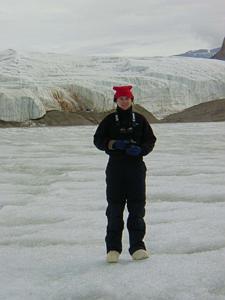22 November, 1999
McMurdo Station, Ross Island, Antarctica Monday
"Life moves pretty fast. If you don't stop and look around once in awhile,
you might miss it."
Ferris Buehler
Julie and I spent the day working at the gas chromatograph (GC). Bess is
still happy with the results of our efforts. Again, Bess, Mark, Maite were
stopped from getting to Lake Bonney because of weather. I'm not certain if
it was wind, visibility, or what. When the helo pilots say they won't fly,
you don't fly. I'm glad they are safety conscious, but we are getting far
behind our goal. Remember that we lost almost an entire week waiting in
Christchurch.
Many of the scientists and technicians are kept waiting to leave McMurdo for
remote field sites. This station is the hub for most inland flights.
Whether you are leaving for a day trip to the Dry Valleys or for a longer
stay at the South Pole, you must first stop at McMurdo. I have spoken with
numerous scientists waiting to leave for places with names like Byrd
Station, Siple Dome, Mount Newell, and Wright Valley. Many, like our group,
have a set amount of time in which to accomplish the collection and analysis
of numerous samples. Others, such as the ITASE team (to be discussed in a
later journal), have a specific amount of data that they need to collect
regardless of the length of time it takes. Getting home for the holidays is
a top priority for many of us! It's frustrating to finally be scheduled on
a helo only to wake up to clouds, snow, wind, and poor visibility! Without
samples, there isn't any work...unless you get creative! And that's what
many scientists must do to feel that they are using, to the fullest, the
precious time they have been given in Antarctica.
Hopefully, tomorrow, members of our team will finally get into the field for
a second day of sampling. Though our first experiment has not concluded, we
are anxious to get started on our second! This will increase our workload,
but our curiosity is much greater than our fear of too much work!
ANSWER TO YESTERDAY'S QUESTION: Katabatic winds in Antarctica are the
strongest of all steady winds found on the Earth. At Dumont d'Urville
Station, winds have been clocked at 200 mph. As the winds descend from the
polar plateau, they gain pressure and temperature. Katabatic winds occur on
clear nights when colder, denser air forms near the ground. This air moves
down the slope of the polar plateau generating winds that travel at great
speeds.
TODAY'S QUESTION: How thick does the ice get in Antarctica?
Sharon
JUST FOR KIDS!!!!! Julie and I worked at the gas chromatograph (GC) all
day. Again, our team did not get to go to Lake Bonney because the weather
was bad. When the helicopter pilots say they won't fly, then you don't fly.
I'm glad they want to be safe!
Many of the scientists must wait a long time to leave McMurdo Station. This
station is the center of activity for scientists traveling to many other
parts of Antarctica. Some scientists have only a few weeks to gather
samples. Others will return home when they have gathered a certain amount
of information. Most of us want to get home for the holidays!
Hopefully, tomorrow, our team will finally get to Lake Bonney for some more
water samples. We are anxious to get started on our second set of
experiments!
ANSWER TO YESTERDAY'S QUESTION: Katabatic winds in Antarctica are the
strongest of all steady winds found on the Earth. At Dumont d'Urville
Station, winds have been clocked at 200 mph. As the winds move down from
the polar plateau (at the South Pole), they gain pressure and temperature.
Katabatic winds occur on clear nights when colder, denser air forms near the
ground. This air moves down the slope of the polar plateau creating winds
that travel very fast!
TODAY'S QUESTION: How thick does the ice get in Antarctica?
Sharon

Sharon, Maite, and Julie remembering warmer days in Akaroa, New Zealand!

Julie modeling the latest in fashionable hats on West Lake Bonney. Blood Falls can be seen in the background.
Contact the TEA in the field at
.
If you cannot connect through your browser, copy the
TEA's e-mail address in the "To:" line of
your favorite e-mail package.
|
